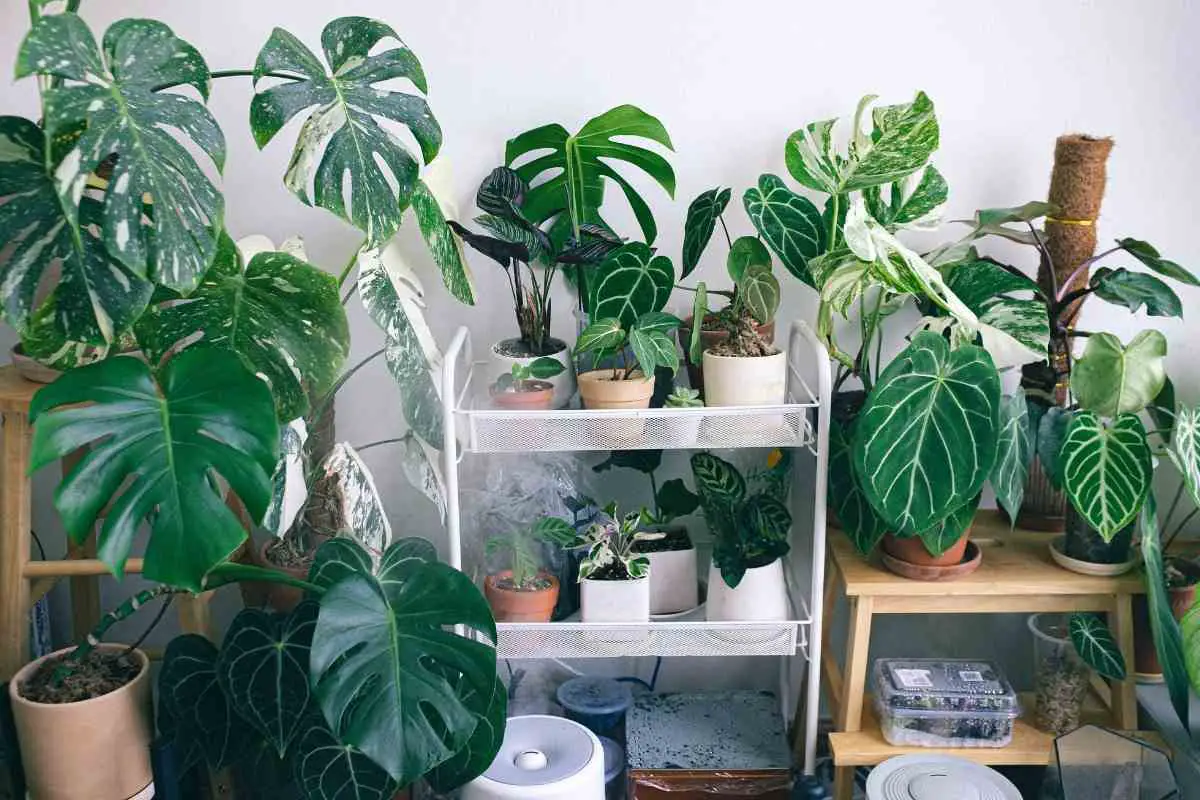Everybody desires something big – a big, well-paying job, a big house, an expensive car, etc.
However, most people draw the line when it comes to enormous indoor plants.
How will it fit?
Is its size going to overshadow everything else in my house? These are the questions many homeowners ponder.
The positioning of your indoor plants determines the final look of your living room, regardless of size.
For Example – A big-leaf plant won’t look out of place if you place in it a strategic location. Likewise, a miniature plant will be unnoticeable if you don’t get the arrangement right.
Here are some popular indoor plants with the biggest leaves.
What Indoor Plants Have Really Huge Leaves?
1. Monstera
Monstera houseplants owe their increasing popularity to multiple appearances on home décor websites and social media.
Still, there’s little research on this variety of large houseplants.
Many homeowners don’t know to take care of and identify the ‘true’ monstera.
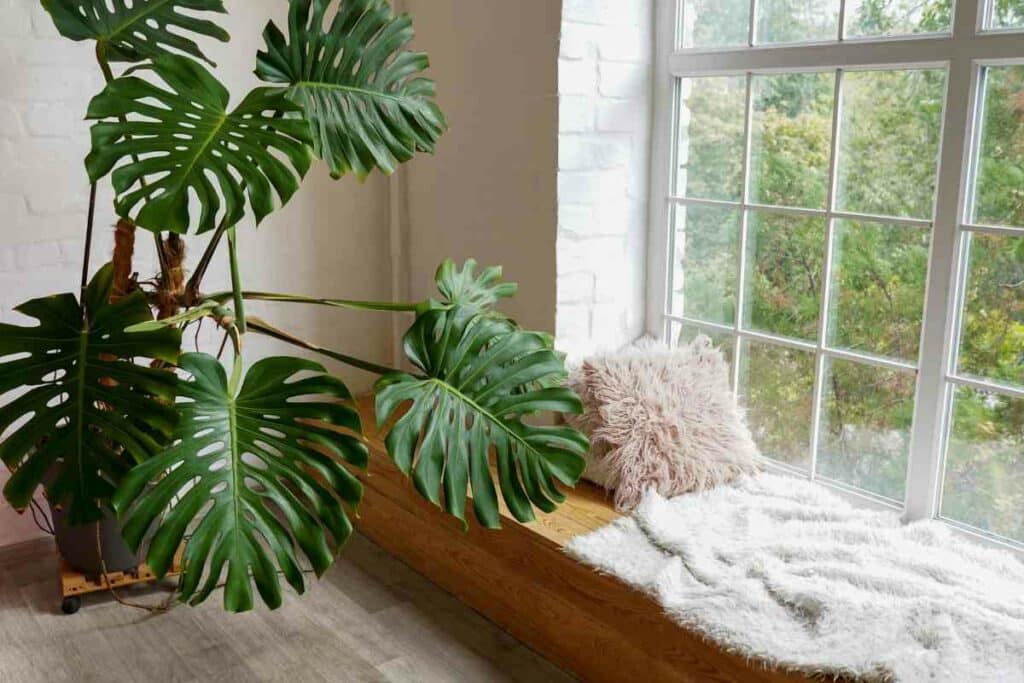
The most common species, Monstera deliciosa, is available in many grocery and flower stores where it’s known as monstera.
It has oversized perforated leaves that add a tropical feel to any space.
It’s advisable to learn more about your preferred variety before purchasing.
Most monstera houseplants grow to 12 feet tall, with leaves up to four feet long.
Unfortunately – Monstera deliciosa is mildly toxic to humans and furry pets. When ingested, it causes stomach upsets and irritates the skin around the mouth.
2. Fiddle Leaf Figs
Before Monstera, Fiddle Leaf Figs were the preferred choice for plant bloggers.
Their stunning large, waxy fiddle-shaped leaves make them a beautiful addition to that unoccupied corner in your living room.
Moreover, you can prune the leaves into your preferred size and shape.
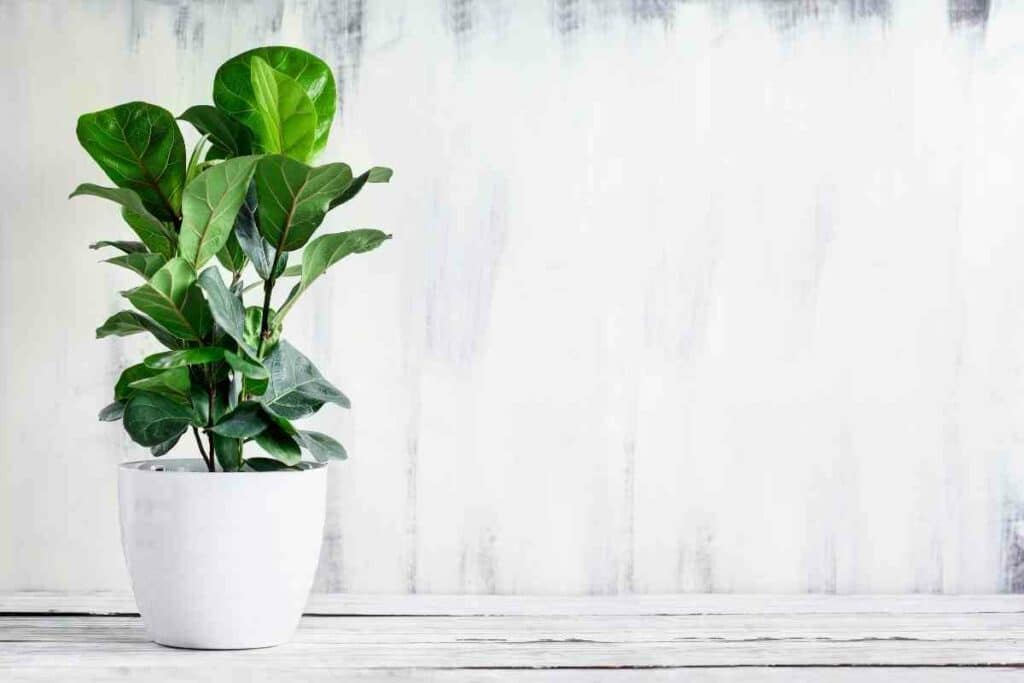
However, fiddle figs require more attentive care than most indoor plants.
First, it’s best to place the plant next to an east-facing window since it doesn’t thrive under direct sunlight.
You also need to check the water such that it’s always moist but never saturated. Thirdly, these plants don’t do well if you move them frequently.
Like Monstera – the leaves of fiddle fig trees are harmful to humans and pets. Please seek immediate medical attention if ingested.
3. Tropic Snow Dumb Cane
The Tropic Snow Dumb Cane is among the largest varieties in the dumb cane family.
It can grow up to 10 ft in indoor conditions.
Its broad, textured, variegated leaves make it a popular choice for homeowners who desire a tropical-themed indoor space.
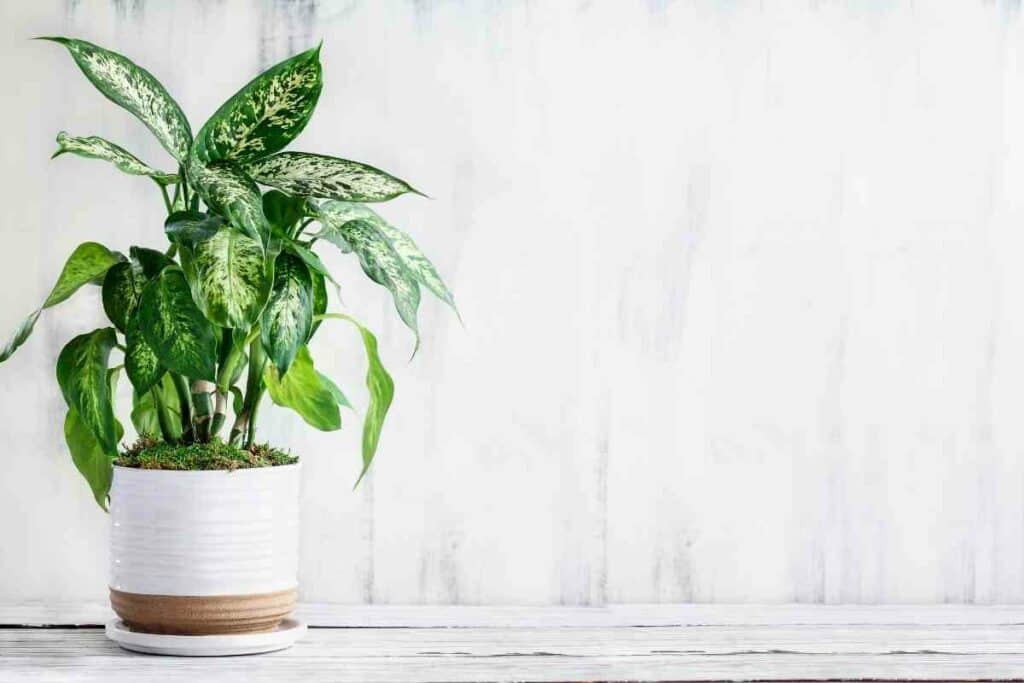
Additionally, tropic snow dumb canes require little maintenance.
The plant can tolerate poorly-lit environments and grows with little water. You need to water it once weekly when the foliage feels dry.
Tropic snow dumb canes grow tall under the optimal conditions.
They’re ideal for homes with high ceilings without potential obstructions like light fixtures and furniture.
On the Downside – This plant is toxic to cats, dogs, and humans. It causes rashes, skin irritation, and stomach upsets when ingested.
4. Calathea orbifolia
Calathea orbifolia is a prayer plant with distinctively large, orb-shaped leaves.
This plant thrives in humid environments, making it a bit too much for homeowners who don’t have the time or equipment to create such conditions.
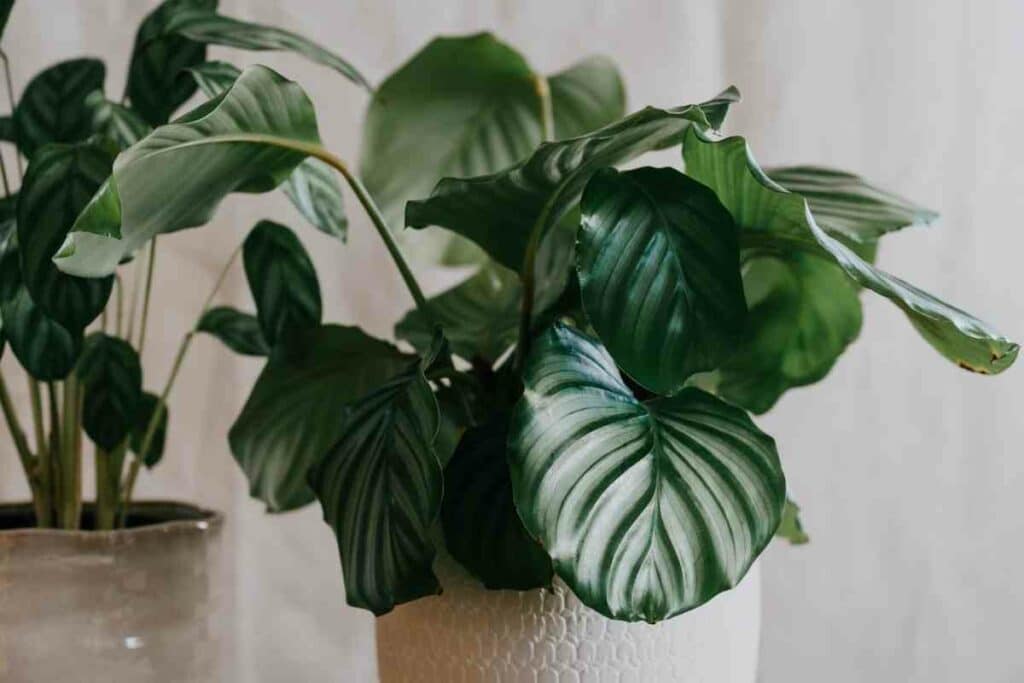
The plant’s leaves can grow up to 6ft long upon maturity.
Ideally, you should grow the plant on moist but unsaturated soil, away from direct sunlight.
Also, it is advisable to water once weekly and apply fertilizer every three months for lush green foliage.
Good News – Unlike other large houseplants, calathea is non-toxic to pets and human beings.
5. Rubber Plant
Rubber Plant has large dark oval leaves, but they aren’t as huge as other plants.
It’s available in multiple varieties with colorful leaves. Most species can grow up to 10 feet tall.
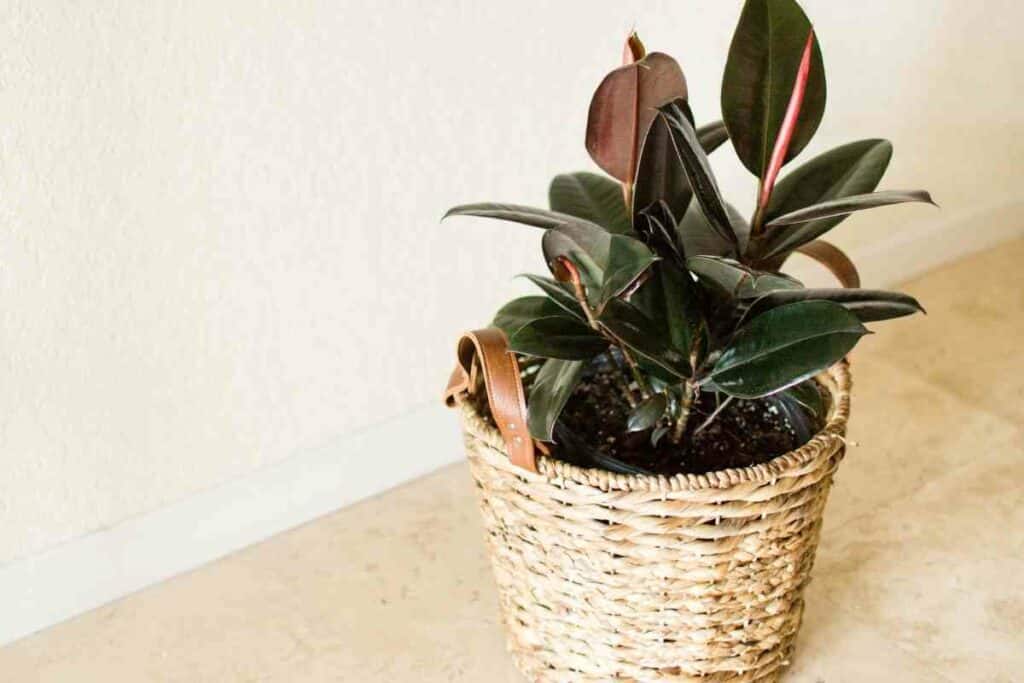
Rubber plants are arguably the most beginner-friendly indoor plants with big leaves.
You don’t need a lot of money to acquire a short tree.
Moreover, they grow fast – a plant can gain more than two feet in one growing season.
When the plant produces suckers, separate them and move them to larger pots to prevent entanglement and root rot.
Rubber is non-toxic, but it has sticky sap that stains clothes.
6. Banana Plants
Banana plants have characteristic lush dark green leaves that create a tropical feel. Most banana species produce edible fruits.
It’s wise to ask your dealer if the variety you’re purchasing is safe for consumption.
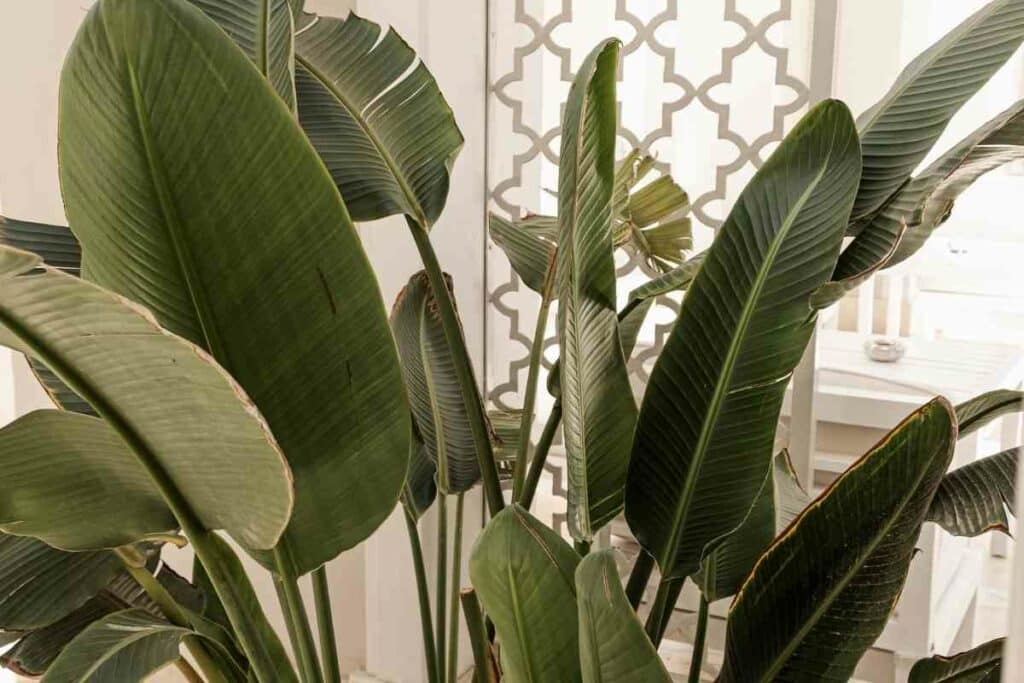
Regardless, the banana tree plant is a brilliant addition to your indoor space.
They require a lot of light, meaning you should grow them near windows.
If your house doesn’t have sunny spots, you can use artificial light fixtures.
Keep in Mind – Ensure that the soil is moist throughout but never saturated. Also, avoid exposing your plants to cold temperatures below 55oF.
7. Bird of Paradise
The Bird of Paradise is so-called because its huge leaves look like the feathers of a flying bird.
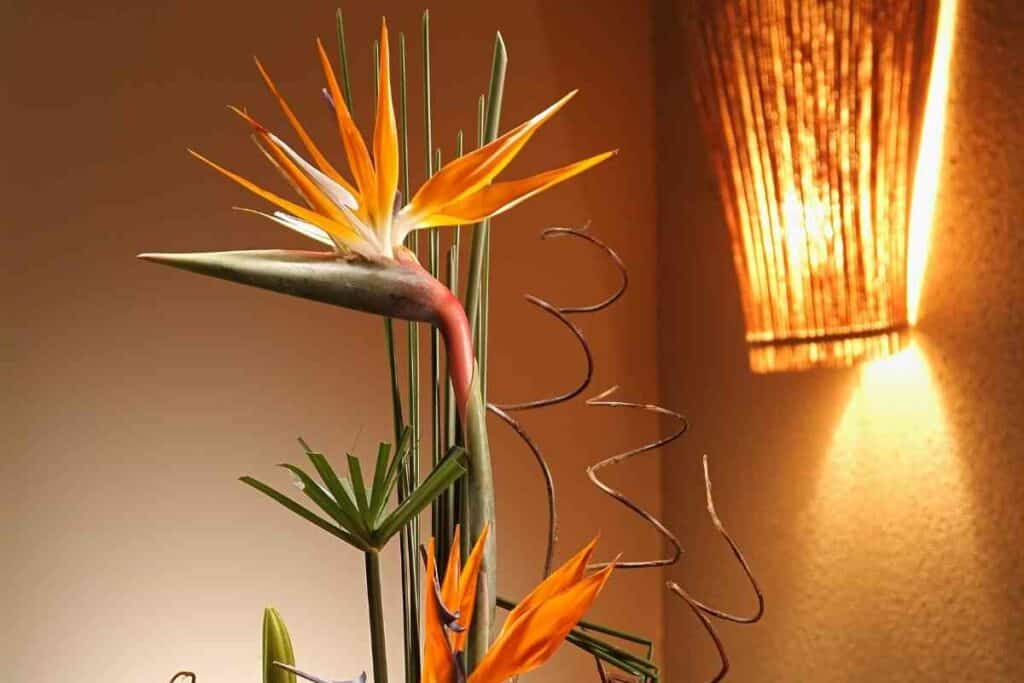
The leaves grow in a self-leading mannerism – this means that they sprout in layers from one central stalk.
A mature bird of paradise measures seven feet high and up to four feet wide. Despite its striking appearance, this plant is deadly to cats and dogs.
8. Majesty Palm
As the name suggests, this houseplant has majestic looks.
It has green fronds that grow on top of multiple stems. When mature, it reaches up to 10 feet tall.
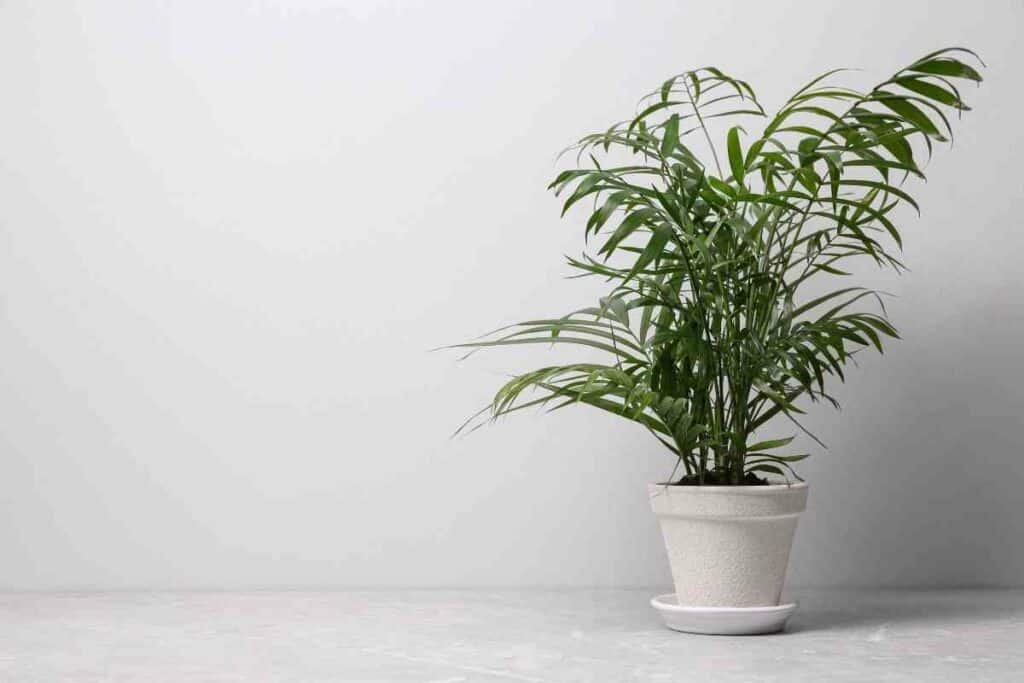
Unfortunately, this houseplant requires close maintenance.
Getting the right balance of light, fertilizer, and temperature isn’t easy.
It’s best to leave the Majesty Palms for expert growers and individuals with a green thumb.
On the Positive Side – Majesty plants are non-toxic to humans and pets.
9. African Mask Plant
The African Mask Plant is a beautiful indoor plant with large, deep green leaves, with a touch of light green and white veins.
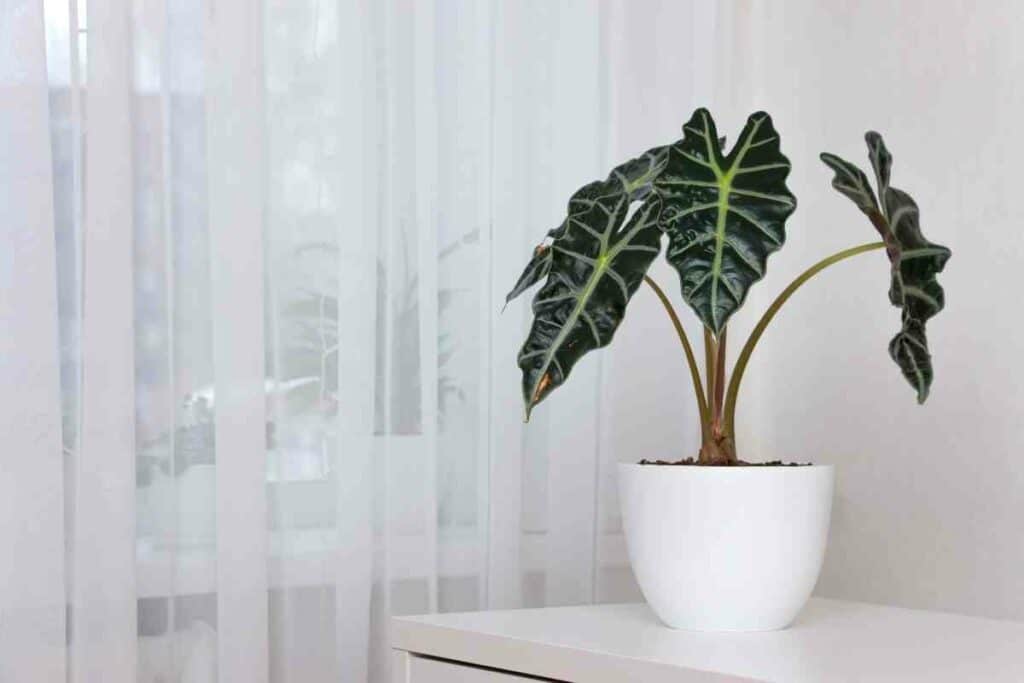
The leaves resemble arrowheads, and their lower surface is usually deep purple.
Because of its African origin, this plant thrives in sunny and humid environments with well-draining soil.
You also need to water it at least once weekly.
However, African Mask Plants are harmful to cats, dogs, and human beings if ingested.
10. Elephant Ear Plant
Although most people grow Elephant Ear Plants outdoors, they won’t look out of place inside your house.
Depending on the species, the leaves can grow up to three feet long.
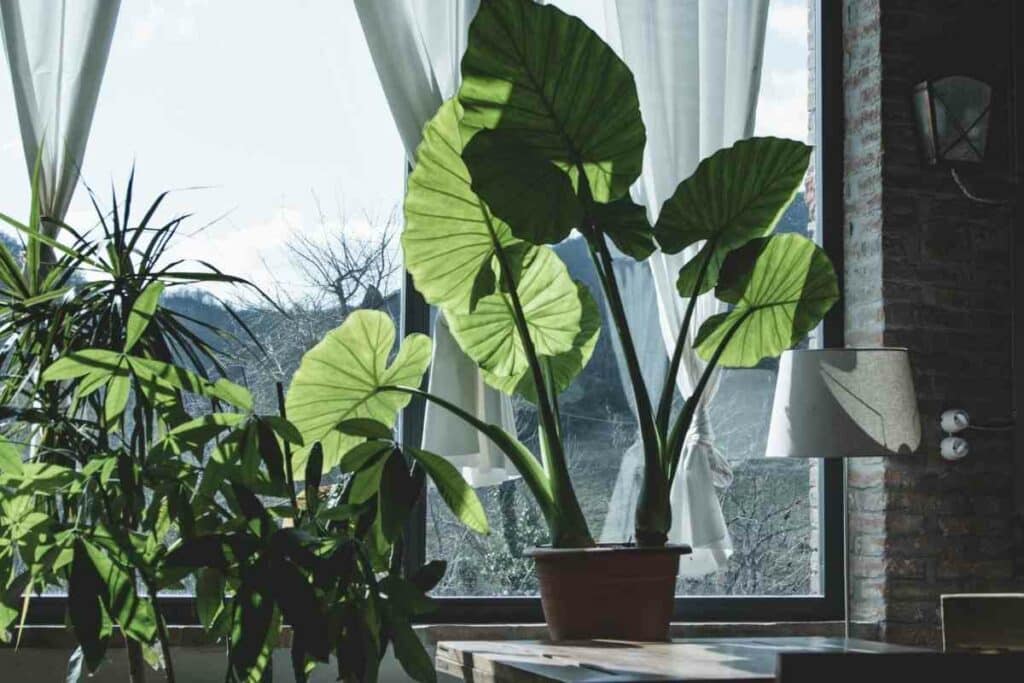
With this plant, frequent watering is unnecessary.
You only need to water if the soil feels dry to the touch.
Too much water makes the soil soggy, slowing down growth rate and increasing root rot risk.
Also, avoid exposing this plant to direct sunlight. Instead, place it in a position where it receives filtered light from south-facing windows.
The Elephant Ear Plant is toxic to pets and humans. Ensure that you keep it away from your kids, cats, and dogs.
11. Sansevieria Plant
The sansevieria plant has wide, deep green leaves.
It grows under low-light conditions and doesn’t require much care, making it the perfect houseplant for many.
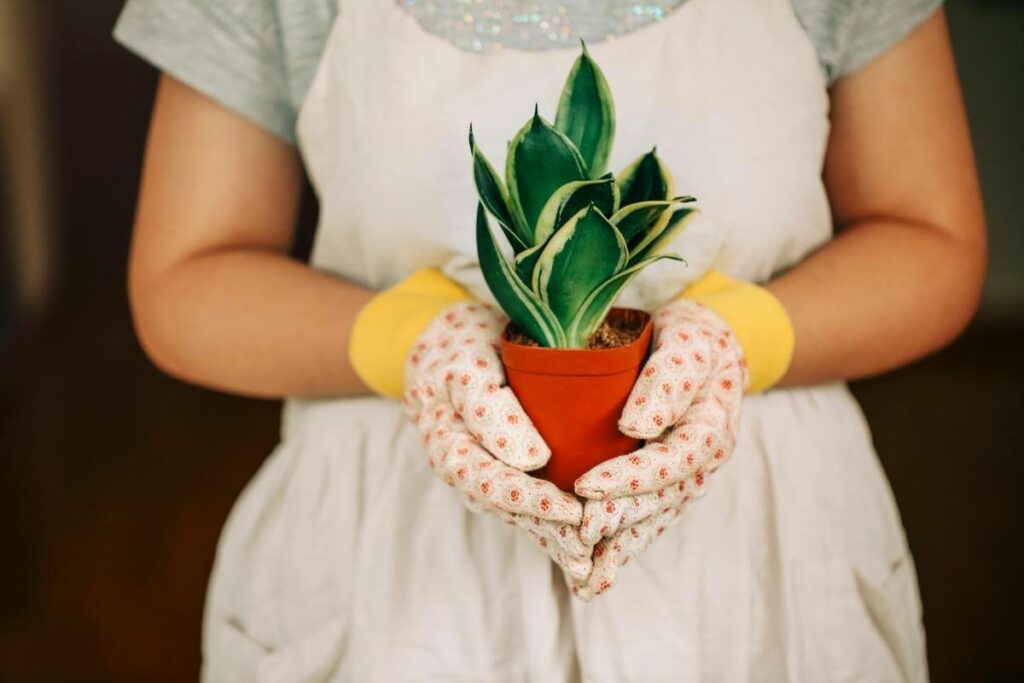
The most common challenge of growing sansevieria is root rot resulting from too much watering.
Ensure that you don’t saturate the soil when watering.
Also, avoid placing the plant under direct sunlight to prevent withering.
12. Ruffled Fan Palm
The Ruffled Fan Palm is a peculiar species.
It has large pleated leaves that look like handheld fans.
Despite its rarity, this plant is easy to grow and requires little maintenance.
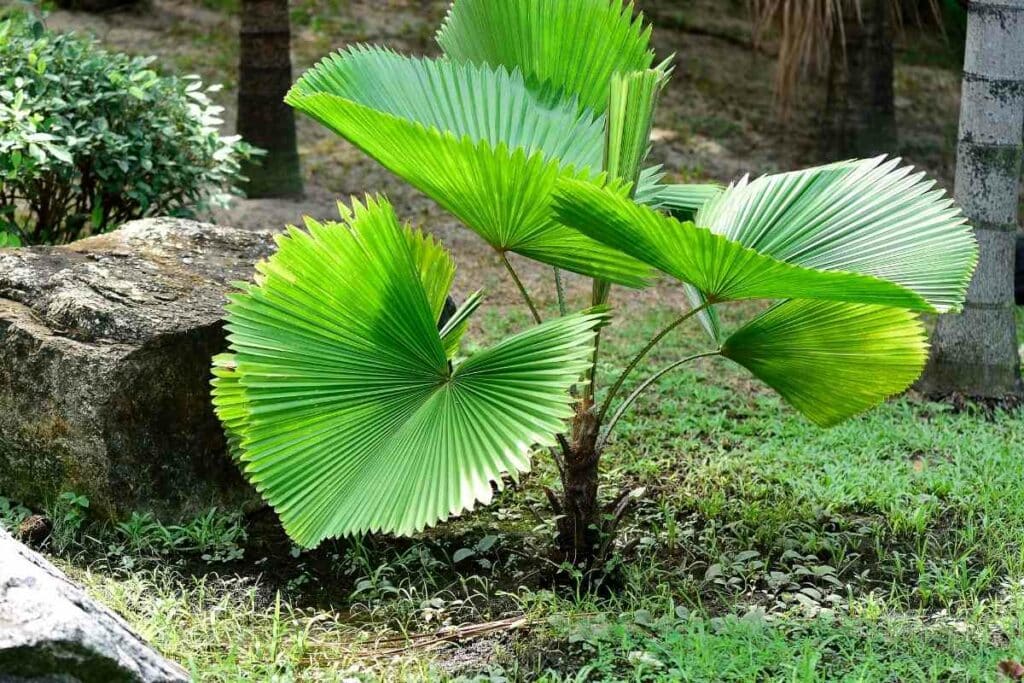
The best location for a ruffled fan palm is a spot that receives partial sunlight.
If it’s next to a window, ensure that you install a sunlight filter to avoid scorching the leaves. This plant is non-toxic to pets.
13. Dracaena marginata
The Dracaena family has many varieties, with the Dracaena marginata being the most popular.
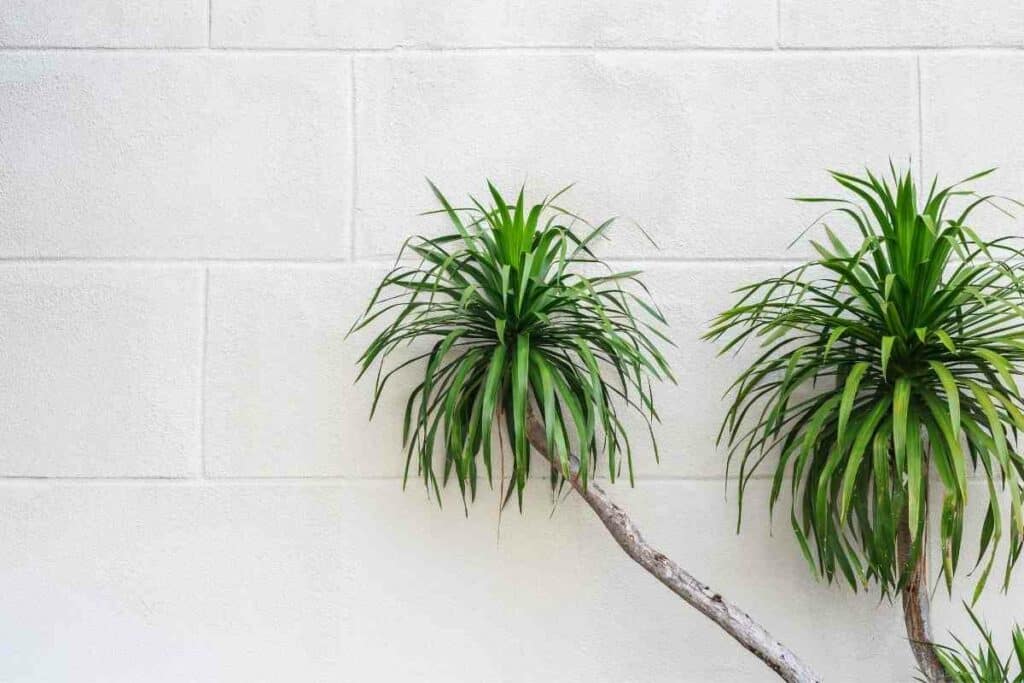
It grows up to 8ft tall under the right conditions and has several spiky leaves that dramatically affect your indoor garden.
These, combined with its willowy stem, makes this large houseplant ideal as a statement piece.
Caring for Your Indoor Plants
There’s no need to grow indoor plants if you neglect them. Poor maintenance defeats the purpose of growing houseplants.
Here are some useful tips for caring for your indoor plants with big leaves.
Watering
You must water your plants at the recommended intervals to prevent yellowing leaves and death.
When watering, ensure that you use the right amount of water.
Too much water saturates the soil, causing a slow growth rate and increasing the risk of root rot.
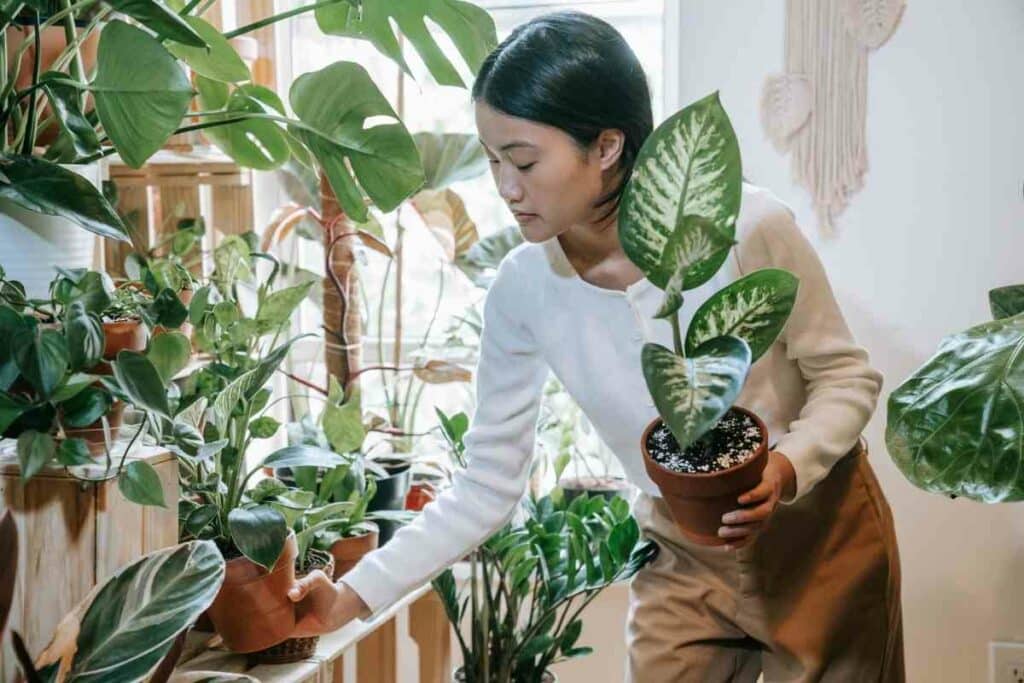
Avoid polishing leaves
Some homeowners use leaf polish to make their plants shinier. This is unnecessary and potentially harmful to your plants.
Instead, use a damp cloth to wipe the leaves. If you notice stubborn stains, use soapy water. If you notice grease stains, use vinegar to get rid of them.
Wrapping Up
Bigger plants add color and freshness to your indoor space.
They’re more effective than smaller leaves because you need fewer pieces to fill up your space.
Also, their size makes them easier to notice, especially if you want an item that stands out from the rest of your decorations.
However, some houseplants require specific conditions that many struggle to create. Also, some are toxic to pets and humans.
Ensure that you get thorough information about a plant before bringing it home.
